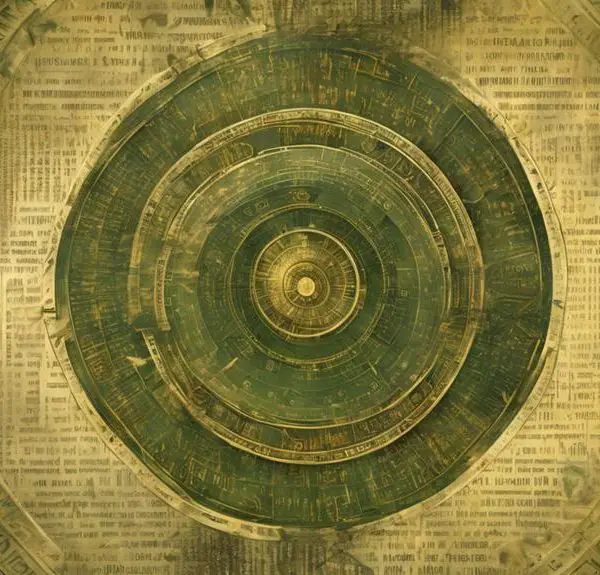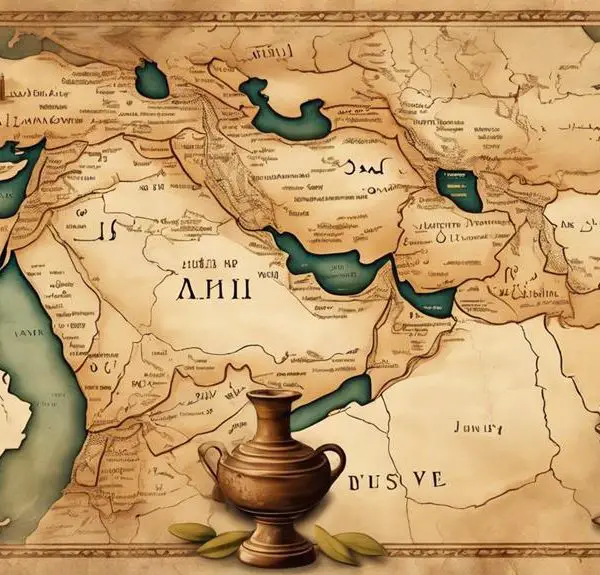Yearn to uncover the profound historical and spiritual significance of the biblical ram's horn, a symbol that transcends mere musicality.

Ram's Horn in the Bible
You might think the ram's horn, or shofar, is just a simple musical instrument mentioned in the Bible, but it's far more significant than that. This ancient symbol carries deep historical and spiritual meanings, from its role in the binding of Isaac to the dramatic fall of Jericho's walls. Its ceremonial use and prophetic significance weave through traditions and stories that have shaped cultures and faiths.
As we explore its origins, symbolism, and impact, you'll discover layers of meaning that could shift your understanding of biblical narratives and their relevance today. Let's uncover the echoes of the past that resonate with our lives today.
Key Takeaways
- The shofar symbolizes divine intervention, salvation, and a call to repentance in biblical narratives.
- It plays a crucial role in Jewish ceremonies, connecting the faithful to their heritage.
- The sound of the shofar marks significant biblical events, from the Binding of Isaac to the Fall of Jericho.
- The shofar signifies the power of faith over might and heralds the Messianic Age in prophetic significance.
Origins and Symbolism

The ram's horn, or shofar, holds deep symbolic significance in Biblical traditions, serving as a multifaceted symbol of alarm, call to worship, and announcement of important events. Its material composition directly links it to the natural world, crafted from the horn of a ram, and not from any bone or ivory, distinguishing it in both texture and resonance. This choice of material isn't arbitrary but steeped in the symbolism of sacrifice and submission to divine will.
You'll find that cultural adaptations of the shofar have allowed it to remain a vital component of religious ceremonies across different Jewish communities. The way it's blown and the occasions it marks vary, reflecting the diversity within these communities. Yet, its core significance as a conduit for communication with the divine and the communal has remained unchanged.
Analyzing the shofar's origins reveals its role as more than just an ancient musical instrument. It's a living artifact that embodies the continuity of faith and tradition. Its enduring presence in religious practices underscores its adaptability and the deep-rooted cultural and spiritual values it represents. Through its sounds, it not only calls the faithful to action but also connects them to their ancestral heritage.
The Binding of Isaac
Delving into the story of the Binding of Isaac, we uncover a pivotal moment where the ram's horn emerges as a symbol of divine intervention and salvation. This narrative presents a profound moral dilemma, challenging the boundaries of faith and obedience. At its core, the tale scrutinizes the father-son relationship between Abraham and Isaac, set against a backdrop of divine command and human response.
The moral quandary that Abraham faces—whether to obey God's command to sacrifice his son—highlights the tension between divine will and human ethics. Abraham's unwavering faith is tested, pushing the boundaries of rational understanding and familial bonds. It's within this crucible of faith that the ram's horn plays a critical role, signaling God's intervention to spare Isaac's life. This act not only preserves the father-son relationship but also redefines it, imbuing it with a deeper sense of purpose and divine mission.
Analyzing this moment, one can't help but reflect on the larger thematic implications it holds for understanding faith, obedience, and the human condition. The ram's horn, thus, transcends its physicality, becoming a beacon of hope and divine grace amidst the profoundest of human dilemmas.
The Fall of Jericho

In analyzing the biblical narrative of the Fall of Jericho, it's imperative to recognize how, once again, divine intervention plays a crucial role in shaping the outcomes of human endeavors. The account, rich in symbolism and miraculous occurrences, underscores a departure from conventional military strategy, guided instead by faith and the following of divine commands. This event isn't only pivotal in the Israelites' conquest of Canaan but also serves as a testament to the power of belief and obedience.
When you delve into the story, several key aspects emerge:
- Archaeological evidence suggests the walls of Jericho did indeed collapse, though interpretations vary on the cause and timing.
- The narrative challenges traditional military strategy, replacing brute force with a ritualistic approach involving the ram's horn.
- The role of the ram's horn underscores the belief in divine intervention over human might.
- The account serves as a critical junction in the Israelites' journey, illustrating the transition from wandering to settlement.
The Shofar's Ceremonial Use
Numerous traditions across various cultures have utilized horns in ceremonial practices, yet the Shofar holds a uniquely central role in Jewish religious ceremonies, emblematic of its deep-rooted significance and multifaceted symbolism. Its sound production isn't merely a function of its form but resonates with historical and spiritual connotations, permeating Jewish life with a reminder of their ancestral faith and continuity.
The technique of playing the Shofar, honed over centuries, underscores its ceremonial use. It's not merely about producing sound; it's about invoking a specific mood or spiritual state among the congregation. The Shofar's blasts—Tekiah, Shevarim, Teruah—each carry distinct meanings, from calling the community to repentance to signaling the start of important religious festivals like Rosh Hashanah and Yom Kippur.
Modern adaptations have seen the Shofar transcend its traditional settings, integrating into contemporary Jewish practices while maintaining its ceremonial essence. Innovations in crafting and playing techniques have enriched its sound quality, ensuring that its ancient call remains as compelling in modern contexts as it was in biblical times. This evolution illustrates the Shofar's enduring relevance, bridging past and present in Jewish ceremonial life.
Prophetic Significance

Beyond its ceremonial use, the Shofar holds profound prophetic significance, serving as a bridge between the divine and humanity in biblical narratives. Its sound not only calls the faithful to repentance and worship but also symbolizes key prophetic themes, including End times predictions and Messianic expectations.
In exploring its prophetic role, consider these aspects:
- Announcement of the Messianic Age: The Shofar's blast is often associated with the arrival of the Messiah, signaling a period of ultimate redemption and peace.
- Call to Repentance: Its sound serves as a divine alarm, urging individuals to reflect, repent, and prepare spiritually for the End times.
- Symbol of Divine Intervention: In narratives of battle and victory, the Shofar signifies God's intervention in human affairs, often leading to miraculous outcomes.
- Harbinger of Judgment: During the End times, the Shofar is depicted as sounding to herald the final judgment, gathering the faithful and announcing the establishment of God's kingdom on earth.
These elements underscore the Shofar's multifaceted role in biblical prophecy, bridging past and future, earth and heaven, and humanity and the divine, underscoring its enduring significance in Jewish eschatology and theology.
Frequently Asked Questions
How Does the Concept of the Ram's Horn Differ Across Various Cultures and Religions Outside of Judaism?
In exploring how the concept of the ram's horn diverges across different cultures and religions, you'll find its use steeped in ancient rituals and imbued with cultural significance.
From signaling in battle to ceremonies marking seasonal changes, the ram's horn serves various symbolic purposes.
Its role extends beyond mere communication; it's a profound emblem of power, fertility, and divine intervention, reflecting the values and beliefs of each society.
In What Ways Have Modern Interpretations or Artworks Incorporated the Image or Symbol of the Ram's Horn?
You'll find modern interpretations and artworks weaving the symbol of the ram's horn into a tapestry of cultural narratives. These symbolic interpretations stretch beyond ancient texts, infusing contemporary art with layers of meaning.
Artistic renditions often explore themes of strength, renewal, and sacrifice, painting the ram's horn as a multifaceted emblem across various mediums.
Scholars analyze these works, uncovering the depths of its symbolism in today's artistic and cultural landscapes.
Are There Any Specific Dietary Laws or Restrictions in Judaism Concerning the Animal From Which a Ram's Horn Is Taken?
In Judaism, dietary laws don't specifically address the animal providing a ram's horn. However, the broader principles of Kosher certification and animal welfare are relevant.
If you're consuming products from the animal, it must meet kosher guidelines, which include humane treatment and specific slaughtering techniques.
While the horn itself isn't eaten, sourcing it from an animal that's been treated and slaughtered according to kosher rules aligns with Jewish dietary and ethical standards.
How Has the Manufacturing Process of Ram's Horns (For Shofars or Other Ceremonial Uses) Evolved With Modern Technology?
You've seen technology transform industries; similarly, it's revolutionized how ram's horns are crafted.
Modern techniques have enhanced sound amplification, ensuring each note resonates more clearly. Additionally, material sustainability practices are now integral, ensuring the preservation of resources while maintaining tradition.
With these advancements, the process not only respects the past but also embraces the future, striking a balance that's both innovative and mindful of environmental responsibilities.
Can the Ram's Horn Be Found in Any Contemporary Jewish Music or Popular Songs, and if So, How Is It Used?
You'll find the ram's horn in contemporary Jewish music and various popular songs across musical genres. Its distinct sound, after undergoing horn tuning, adds a unique layer to compositions. Artists often use it to evoke deep cultural or spiritual connections, blending tradition with modernity.
Its presence in music isn't merely for novelty; it serves as a bridge between ancient practices and today's diverse musical landscape, enriching the auditory experience with its profound resonance.
Conclusion
In analyzing the ram's horn, or shofar, its profound symbolism and usage throughout biblical narratives are undeniable. From its role in the Binding of Isaac to the Fall of Jericho, the shofar has served as a powerful instrument of divine intervention and human action.
Notably, it's used in over 70 instances in the Bible, highlighting its ceremonial and prophetic significance. This statistic underscores the shofar's enduring legacy as a spiritual symbol, connecting past traditions to present ceremonies and future prophecies with remarkable continuity.



Sign up